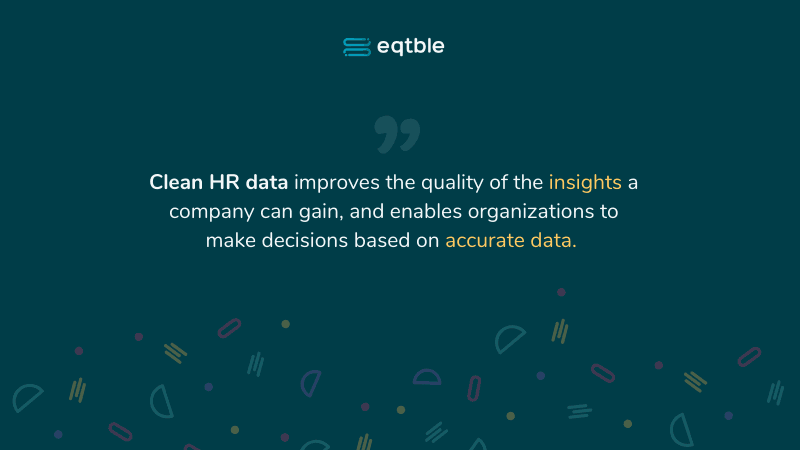HR Analytics
July 18, 2022
Clean Data: for Good Analytics, You Need Good Ops
Your HR analytics can only be as good as your data. If junk goes in, junk comes out.
It’s not always immediately obvious when you’re dealing with huge volumes of data – but gaps, mistakes, or mislabelled entries in your HRIS (even just simple typos) can seriously undermine the trustworthiness of your data, and the quality of the insights you can get from it.
When you’re dealing with data at any kind of scale, accuracy and validity are vitally important. In HR analytics, dirty data can be as damaging to the company as it is to the individuals whose data is affected. But let’s be real; perfection is unattainable, and sometimes even finding missing data won’t change the end result.
Even though there’s no such thing as “perfect data”, striving for good, unbiased, clean data is always going to be best practice. And while that should begin at the source, good operations and data audits can help resolve issues with dirty data after collection.
Why is it important to have clean HR data?

HR departments commonly use a suite of best-in-class tools for HCM and employee data collection, to obtain the most accurate overview of their workforce.
However – combining multiple data sources presents opportunities for the data to be duplicated, incorrectly labeled, or corrupted by incorrect conversion. This makes the data unreliable, even if it looks correct after processing.
Working with clean data improves productivity by maximizing the efficiency of HR analytics workflows. Data audits are conducted to find problems and errors in the data, before it’s fed into HR dashboards and analyzed. Clean HR data improves the quality of the insights a company can gain, and enables organizations to make decisions based on accurate data.
Just as importantly, reliable data gives employees greater confidence in their company’s HR process and contributes to fair and accurate evaluations. For HR teams, clean data enables transparency, proper goal-setting and saves doubling up work due to troubleshooting later down the line.
So, how do we get it?
Clean data starts at the source. But...
The integrity of data is best maintained when it is input accurately to start with. Wherever possible, data needs to be entered fully and precisely at the source.
This can be challenging for several reasons; using multiple platforms to collect data being one. Labels may appear differently in one piece of HR software to another, or have different meanings – some might use outdated information.
The biggest challenge? Human error. Our brains are not perfect data-processing machines, and our hands are not perfect data-entry robots. We make typos, read things incorrectly, and even with the best of intentions, we’re prone to making mistakes.
Take employee engagement surveys, as an example. The data that these collect can never be perfect, especially when conducted at scale.
Read more: Employee engagement surveys vs pulse surveys
Large employee surveys can be seen as productivity killers. Some team members might just breeze through them without thinking about the significance of providing inaccurate data. But survey results aren’t just a product of the time they take to complete – they can be skewed by everything else that makes us human; things like our mood, and our health.
These aren’t the only issues, though. What about data collected during onboarding? What if a recruiter skips an important part of your onboarding process, but you’re not aware?
What if an employee doesn’t have all their information available during their onboarding? Or if they agree to a change in salary, but spot an error on their first paycheck – are changes and errors followed up and logged – not only in the main HRIS, but all other HCM platforms?
It’s clear that there are way too many factors at play to ensure total data accuracy on the way in. Even with stringent processes and good ops in place, errors, while reduced, are always going to be unavoidable.
A combination of human error, legacy systems, and multiple data sources can make data cleanliness at the source an impractical goal – and so, data needs to be cleaned after collection, and before analysis.
That’s where data audits come in.
Cleaning data after collection
As we’ve said, perfection isn’t possible – or even that desirable. But good HR analytics needs good data to be effective, and it’s important to know what the hallmarks of good data are, and the questions you should be asking:

Data audits find mistakes in data and seek to eliminate them. These can be anything from relabelling sources correctly, to filling in gaps by finding the source information – or removing duplicates and corrupted data.
These audits can be incredibly time-consuming and resource-intensive, even when performed on specific data sets to accomplish a particular goal or prove a theory.
A simple data cleaning process might look something like this:
Check that the data is up to date
Check for multiple employee records, condense as necessary
Remove duplicated data
Identify missing data – flag for investigation
Check for extremes and statistical outliers – are these a true representation?
With over hundreds, or thousands, or tens of thousands of employees in your HRIS, the process of cleaning your HR data can technically take years to complete.
This presents a problem. Large organizations seek agility, but HR analytics data can be out of date by the time it’s analyzed, because cleaning and auditing has taken so long. On the other hand, if this process was skipped, the inaccuracy of the data used to make key decisions could cause massive damage, because the insight was inaccurate.
That’s one of the key problems we wanted to solve when we first began developing eqtble.
Since then, we’ve pioneered a fully automated HR data audit process that works with hundreds of HR platforms, designed to give organizations better, cleaner data.
Make decisions with data you can trust
At eqtble, we’ve found the answer to getting clean data, fast. Our platform delivers complete, reliable data audits to enable better employee decisions. Want to know more?







